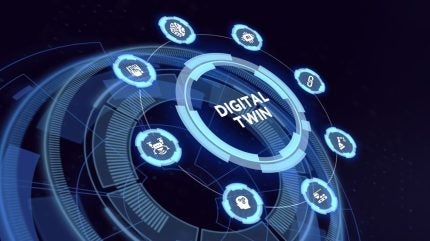
The digital twin market will be worth $154bn by 2030 having expanded at a compound annual growth rate of 35.6% since 2019, according to a new report.
The 2024 edition of GlobalData’s Digital Twins report explores the market for the technology and its impact on numerous industries. The report indicates that growth in the market will be predominantly driven by low-cost sensors used in internet of things devices, a decline in the cost of high-performance computing and improved cloud accessibility.
Digital twins are digital representations of physical assets, systems, people or processes. Creating a ‘live bridge’ between a physical asset and its virtual representation, they integrate data and information about the asset to provide insights that go beyond what can be gained from modelling.
Digital twins can operate on different levels, such as for a constituent component or part such as a blade in a turbine to high-level enterprise-wide models or production plants.
The main benefits of the technology include improving efficiency, sustainability, status monitoring and planning. These benefits have potential utilisations across most industries from manufacturing and energy to infrastructure and sport.
Digital twins in manufacturing
In the manufacturing industry, companies are looking to create digital twins of plants via real-time monitoring, allowing for the optimisation of production. This, in turn, can lengthen the lifespan of equipment and reduce costs.

US Tariffs are shifting - will you react or anticipate?
Don’t let policy changes catch you off guard. Stay proactive with real-time data and expert analysis.
By GlobalDataGlobalData’s report highlights several car manufacturers, such as BMW and Mercedes-Benz, as having partnered with Nvidia in 2023 to create virtual models of factories. Technology company Bosch is also partnering with Multiverse Computing to create digital twins of factories in Madrid, utilising a quantum computer to improve quality control and efficiencies in energy and waste management.
Digital twins in power
In the power sector, organisations are using digital twins in a variety of ways. Among them, the US Department of Energy is utilising the technology for floating offshore wind turbines, with a partnership led by Principle Power providing a real-time representation of the WindFloat Atlantic wind farm off the coast of northern Portugal. The twin allows operators to more deeply understand the performance and operation of the wind farm leading to more efficient and cheaper operating costs.
In the UK, meanwhile, at the start of 2024, the Nation Grid Electricity System Operator signalled interest in developing digital twin energy system infrastructure with help from the government-led National Digital Twin programme by signing a memorandum of understanding.
there is also interest from Australia and Singapore in creating twins of energy grids with aims variously of helping to maintain reliable power supplies, model the effects of weather conditions and model the effects of turbines on wildlife and ecosystems.
Digital twins in healthcare
By creating digital twins of the human body, there is the potential to model the effects of drugs either in development phases or for managing an individual’s condition.
There are several digital twin operations focussed on digital hearts led by TCS, Dassault Systemes and Harvard University. The National Center for Neurology and Psychiatry in Japan is working to develop a brain digital twin to identify and prevent mental illness, while Twin Health has created a whole-body digital twin to help patients mitigate and reverse chronic metabolic disease.
Digital twins in construction
For construction, digital twins can help monitor long-term projects to identify and mitigate potential issues. A digital twin of Ezhou Huaha Airport was created recently using Bentley Systems’ iTwin platform to resolve around 6,000 issues before construction, minimising time spent in the construction process and saving money.
Bentley Systems is a key vendor in this space, creating twins to monitor dam construction, a water treatment plant and for railway upgrades.
Digital twins in automotive
Due to the myriad of constituent parts that make up vehicles, the report highlights that digital twins can be used to improve monitoring. Tesla, for example, makes digital twins of every car it sells, allowing it to update software for individual vehicles based on sensor data. Mercedes-Benz and Renault, meanwhile, are using digital twins to streamline manufacturing processes.
There is also scope to significantly change the second-hand car industry. While the value of vehicles is currently depreciated based on mileage, age and other factors, digital twins and sensors could give a more accurate reflection of vehicle condition, performance, warranty and service history.
Digital twins in aerospace and defence
Digital twins have a similar scope for reducing costs and improving performance in the aerospace and defence sectors.
GE Aviation has created a digital twin of aircraft engine blades for identifying erosion. The company is able to predict the degradation of materials over time.
The US Naval Air Systems Command also uses them to aid the integration of technology into naval aviation, and the US Air Force Research Laboratory for a digital virtual battleground and evaluating aircraft and weapons systems.
Digital twins in government
Governments bodies can use digital twins to monitor the state of existing infrastructure and plan future projects.
The National Research Foundation in Singapore, for example, analyses the potential of rooftop solar energy generation.
The digital twin of Singapore was the first city twin to be created and was completed in 2018, allowing the city to make use of it during the Covid-19 pandemic.
Elsewhere, municipalities are using the technology to reduce carbon output, plan new infrastructure and model the impacts of climate change.
Digital twins in sport
Digital twins in sport can be used for managing venues and monitoring athlete performance. For the upcoming 2024 Olympic Games in Paris, the organising committee is working with OnePlan to help simulate all major competition venues and make them more efficient and sustainable.
Elsewhere, Japanese tech giant NTT has created a digital twin of the race route for the Tour de France cycling event for real-time updates.



